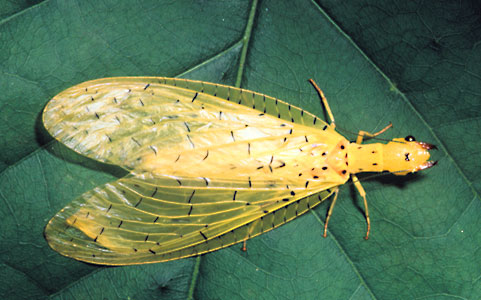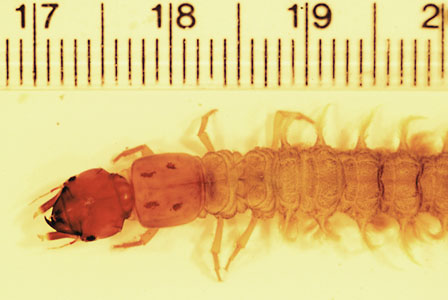Chloronia
Atilano Contreras-Ramos- Chloronia absona
- Chloronia antilliensis
- Chloronia banksiana
- Chloronia bogotana
- Chloronia convergens
- Chloronia corripiens
- Chloronia gaianii
- Chloronia gloriosoi
- Chloronia hieroglyphica
- Chloronia marthae
- Chloronia mexicana
- Chloronia mirifica
- Chloronia osae
- Chloronia pallida
- Chloronia pennyi
- Chloronia plaumanni
- Chloronia zacapa
Introduction
The genus Chloronia Banks, together with Corydalus Latreille and Platyneuromus Weele, is a member of the American lineage of Corydalinae. As the name points out, dobsonflies of the genus Chloronia are easily distinguished because of their greenish-yellowish color, which has a bright appealing tone when the insect is alive. Pinned specimens best maintain color compared with alcohol preserved material. In comparison with the widespread and commonly collected Corydalus, Chloronia fits closely a Neotropical distribution pattern, and so its presence in collections is somewhat more limited. The best way to collect adults is with black or mercury vapor light traps placed next to clean streams or rivers. Distribution records range from southeastern Brazil, through the Amazon region and the Andean countries of Bolivia, Peru, and Ecuador, up to northern South America, Central America, and tropical areas of eastern and western Mexico. One species has been described from the Lesser Antilles. Being no exception, Chloronia is absent from Chile, and interestingly, there are no records from Argentina.
Fifteen species of Chloronia are currently recognized (Contreras-Ramos 1999, and in press), whereas two new species from Venezuela are being described, and it seems likely that a few more new species will be found upon further collecting, especially in South America.
A list of Chloronia species with information on their distribution is available here.
Characteristics
Adults of Chloronia are rather small dobsonflies (forewing length 24–50 mm). Sexes are monomorphic (males and females look alike). Color is characteristic, pale yellowish green, sometimes waxy. Wings of several species look patterned because of dark crossveins or spots, but a few look mostly clear. Head and pronotum typically bear two and four dark markings each, but the head may have only a narrow vitta and the pronotum may have only a pair of spots or bands. Maxillary and labial palps are 5 and 4-segmented, respectively.


Chloronia pallida (Davis), female, Chihuahua, Mexico. Photograph copyright © 1997, Atilano Contreras-Ramos .
Larvae of Chloronia are structurally quite similar to those of Corydalus and Platyneuromus. However, Chloronia hellgrammites are reddish brown, with head and pronotum unpatterned. As in adults of several species, some larvae have 4 dark spots on the pronotum. Chloronia larvae may be quite dark, almost black, but always with a reddish touch. Larvae of Corydalus and Platyneuromus have their head and pronotum patterned, although the pattern may be somewhat hidden in atypically dark specimens. Color of larvae of the latter two genera is typically brownish, sometimes blackish but not reddish. Several other traits of immature stages of American Corydalinae are given by Contreras-Ramos and Harris (1998).
Natural History
Like other dobsonflies, Chloronia adults are nocturnal and secretive. The best way to collect them is setting up light traps close to streams and rivers. During the day, adults take shelter in the canopy along rivers and creeks (Geijskes 1984) and are nearly impossible to find. Very little is known about life history of any of the species. Formal studies to investigate voltinism, phenology, food habits, behavior, and more, would certainly provide interesting information to fill huge gaps. We may speculate in warm tropical latitudes a flight period year round, but with a probable peak associated with the rainy season, as observed by Geijskes (op. cit.) towards the end of the year in the Guyanas. In northern latitudes (e.g., Mexico), adult emergence might be limited by temperature as well, and we might expect a flight season after March and April. Whether species produce more than one generation per year remains an open question.
Some species appear to be restricted to small order streams or to large rivers. For instance, Geijskes (op. cit.) found that C. hieroglyphica (Rambur) always occurred in "shadowed small bush creeks" in the Guyanas. Yet, other species, as the widespread C. mexicana Stitz may be eurytopic. Regarding larval habitat, they are found in similar habitats as Corydalus, for instance under rocks in riffles, in leaf packs in depositional zones, and under bark of submerged wood (Contreras-Ramos 1999).
Discussion of Phylogenetic Relationships
Penny and Flint (1982) provided a hypothetical phylogeny for the species of Chloronia. Unfortunately, several species described afterwards bring up the need for a new phylogenetic analysis. At this time only broad conjectures and a few evident relationships may be proposed. In a similar fashion to Corydalus, there seems to be a phylogenetic pattern from base to top correlated with distribution, beginning with southeastern South American species [e.g., C. corripiens (Walker), C. plaumanni Penny & Flint], going through some intermediates (e.g., C. antilliensis Flint, C. banksiana Penny & Flint, C. osae Flint), and then emerging a complex monophyletic group of South and Central American species. In the latter group there may be a trend from bilobate (C. convergens Contreras-Ramos) to tetralobate 9th sterna. Species such as C. mirifica Navás and C. mexicana Stitz are clear representatives of the latter group. Some species pairs, at this time based simply on similarity, may remain as formal sister species after a formal phylogenetic analysis. For instance, C. mexicana Stitz + C. pallida (Davis), C. absona Flint + C. zacapa Contreras-Ramos. The last species pair includes the only Chloronia species with an 8th sternum produced into a movable plate and 9th gonostylus bearing a basolateral process, traits that may well be advanced as synapomorphies.
Taxonomy
Chloronia was erected by Banks in 1908. But until 1982, when it was revised by Penny and Flint, reliable identification of the species was possible. Penny and Flint recognized 10 valid species in the genus. Later, Flint (1991) redescribed C. bogotana Weele, the only species whose identity remained somewhat unclear after the revision. Flint also, in (1992), revised the genus in Costa Rica and described two new species. Two more new species were added by Contreras-Ramos (1995), each from Ecuador and Guatemala. A 15th species was recently found from southeastern brazil (Contreras-Ramos, in press). Two more new species from Venezuela are currently being described. It may be predicted that a few Chloronia species might still be discovered, especially in South America.
References
Contreras-Ramos, A. 1995. New species of Chloronia from Ecuador and Guatemala, with a key to the species in the genus (Megaloptera: Corydalidae). Journal of the North American Benthological Society 14: 108–114.
Contreras-Ramos, A. 1999. Mating behavior of Platyneuromus (Megaloptera: Corydalidae), with life history notes on dobsonflies from Mexico and Costa Rica. Ent. News 110: 125-135.
Contreras-Ramos, A. 2000. A new species of Chloronia Banks (Megaloptera: Corydalidae) from southeastern Brazil, with a key to the species of Brazil. Proc. Entomol. Soc. Wash. 102: 919-923.
Contreras-Ramos, A. 2002. Six new species of dobsonflies from Venezuela (Megaloptera: Corydalidae: Corydalinae). Aquatic Insects 24: 55-75.
Contreras-Ramos, A., and S. C. Harris. 1998. The immature stages of Platyneuromus (Corydalidae), with a key to the genera of larval Megaloptera of Mexico. J. N. Am. Benthol. Soc. 17: 489-517.
Flint, O. S., Jr. 1991. On the identity of Chloronia bogatana [sic] Weele (Neuropterida: Megaloptera: Corydalidae). Proceedings of the Entomological Society of Washington 93: 489–494.
Flint, O. S., Jr. 1992. A review of the genus Chloronia in Costa Rica, with the description of two new species (Neuropterida: Megaloptera: Corydalidae). Proceedings of the Biological Society of Washington 105: 801–809.
Penny, N. D., and O. S. Flint, Jr. 1982. A revision of the genus Chloronia (Neuroptera: Corydalidae). Smithsonian Contributions to Zoology 348: 1–27.
Geijskes, D. C. 1984. Notes on Megaloptera from the Guyanas, S. Am., pp. 79-84. In J. Gepp, H. Aspöck, and H. Hölzel (eds.), Progress in world’s neuropterology. Graz, Austria.
About This Page

Universidad National Autónoma de México
Correspondence regarding this page should be directed to Atilano Contreras-Ramos at
Page copyright © 2000
 Page: Tree of Life
Chloronia.
Authored by
Atilano Contreras-Ramos.
The TEXT of this page is licensed under the
Creative Commons Attribution-NonCommercial License - Version 3.0. Note that images and other media
featured on this page are each governed by their own license, and they may or may not be available
for reuse. Click on an image or a media link to access the media data window, which provides the
relevant licensing information. For the general terms and conditions of ToL material reuse and
redistribution, please see the Tree of Life Copyright
Policies.
Page: Tree of Life
Chloronia.
Authored by
Atilano Contreras-Ramos.
The TEXT of this page is licensed under the
Creative Commons Attribution-NonCommercial License - Version 3.0. Note that images and other media
featured on this page are each governed by their own license, and they may or may not be available
for reuse. Click on an image or a media link to access the media data window, which provides the
relevant licensing information. For the general terms and conditions of ToL material reuse and
redistribution, please see the Tree of Life Copyright
Policies.
- First online 17 May 2000
Citing this page:
Contreras-Ramos, Atilano. 2000. Chloronia. Version 17 May 2000. http://tolweb.org/Chloronia/12994/2000.05.17 in The Tree of Life Web Project, http://tolweb.org/










 Go to quick links
Go to quick search
Go to navigation for this section of the ToL site
Go to detailed links for the ToL site
Go to quick links
Go to quick search
Go to navigation for this section of the ToL site
Go to detailed links for the ToL site